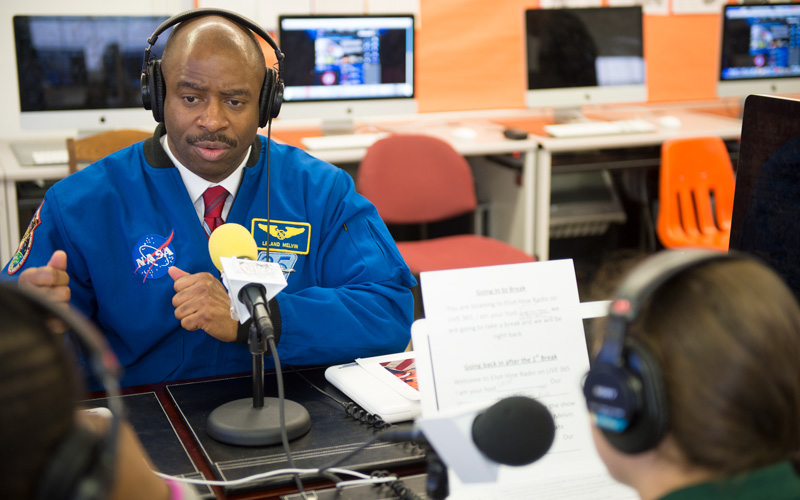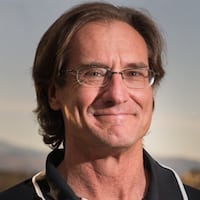The former NASA astronaut and STEM advisor to President Obama focuses his energies on his greatest passion: prepping today’s students for Mars.
A recurring thought crosses Leland Melvin’s mind sometimes when he looks up at the night sky. As he peers into the stars from his Virginia home, and sees the darkness of space he has twice visited, he recalls the ‘the sky is the limit’ sentiment of his childhood, and wonders how to make it equally magical for students.
“Kids might look at the night sky, but then they look down at their devices and tablets – and kind of get stuck there,” he says. “I want to be sure they continue to look up, and get geared into their environment, their universe. I also want them to understand we might have to gear up and look at another body, a planet, an exoplanet. I want them to have this vision.”
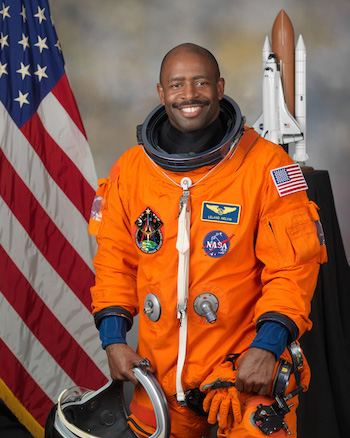
Melvin is also coming at it as the author of two books (including Chasing Space: An Astronaut’s Story of Grace, Grit and Second Chances), and technical advisor on the National Geographic Channel series MARS, created in 2017 by Apollo 13 director Ron Howard and Brian Grazer. Prior to that, Melvin and seven other astronauts co-starred in NatGeo’s One Strange Rock, sharing experiences of Earth from the rare perspective of being a space traveler.
Meanwhile, the pieces of humankind’s greatest exploration are falling into place quickly. In late November, NASA’s InSight robotic lander touched down on Mars for the first-ever deep core and underground exploration of the planet. Space X, NASA, and soon Virgin Galactic are launching both satellites and early prototype machinery for a Mars mission. In the meantime, kids from coast to coast are engrossed in STEM curriculum, robotics, and related classes. Throw in that 2019 is the 50th anniversary of the Apollo 11 mission that landed Neil Armstrong and Buzz Aldrin on the Moon, and Melvin feels the time is now to inject vision, creativity, and purpose into the way we present STEM – with a serving of astronautics included.
“When I was a kid, growing up in the late 60s and 70s, going to school was a lot of fun,” he recalled. “Look at what we aspired to in the classroom. We were sending astronauts into Earth orbit and to the moon. Even then, we were drawing pictures of flying cars and landing on Mars on our school folders, and the experts were talking matter-of-fact about Mars being the natural extension of walking on the moon. The things everyone is talking about today, we talked about then. Since we didn’t have devices and couldn’t go online to Google and look at footage from our telescopes, or deep space vehicles, we had to imagine it. Envision it. So my generation was a generation of dreamers. The difference is, technology is catching up to us now so we can focus on truly sending manned missions to Mars. I’m confident it can happen in my lifetime.”
Melvin’s work on MARS, on which he is one of two astronaut advisors (Dr. Mae Jemison being the other), cuts to the areas he’s most passionate about: matching STEM education with real and imagined space duties, enhancing creativity and vision by throwing the all important “A” into STEAM – arts curriculum – and focusing on the day-to-day of not only fulfilling experiments and tasks, but also existing as a tiny family or community. That, Melvin points out, is particularly critical.
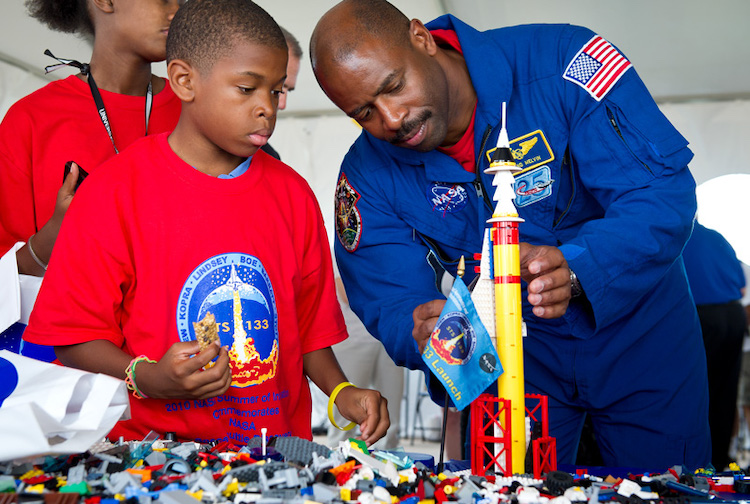
“What we need to understand going into this is that the first mission or two may be a one-way trip, with the astronauts colonizing and staying there,” Melvin says. “We do a lot of things in MARS, from blending documentary with live-action, science with drama, but we also look at the dynamics of the group as they work together, and get used to their newer, much more hostile environment. So while Season 1 was about the novelty of being there, Season 2 focuses on the dynamics of the colonists, along with a major challenge – will it be a private or public operation to mine the resources from beneath the surface? Earth challenges will become Mars challenges at times; we need to show that. Working together is going to be critical, but so is living together.”
To that end, Melvin was thrilled to see Howard and Grazer create and cast a female commander for the mission (played by Korean-American actress Jihae). He felt that sent the proper message not only for the global diversity it represents, but also empowering girls and young women to focus more on science, tech and potentially astronautic careers.
“I love the fact there’s a female Asian commander running things with empathy and love,” Melvin said. “This whole thing about representation matters. Through that commander, more kids can see themselves being the commander of a Mars mission, or being on a Mars mission.
“We’re seeing more and more girls involved with STEM, with STEAM, and looking at the four components of STEM in making their continuing education and career choices. Everything from engineering to robotics, geology to astronautics matters a lot, but so does empowering students to feel like they can get us to Mars – because the actual build-up and manned mission to Mars will happen under their watch, and these kids will be performing jobs that don’t even exist yet.”
Most of all, Melvin lauded the way Howard, Grazer, and the rest of the team dove deeply into his and other advisors’ direct experiences and threaded some of them into the shows. Consequently, he feels MARS will serve as a catalyst to further focus younger viewers on a space component in their STEM-based careers.
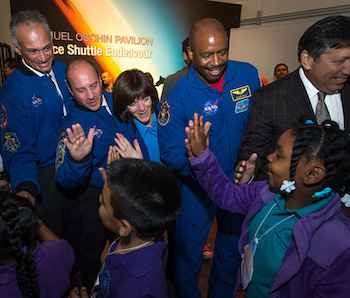
Leland Melvin looks a lot more like a retired NFL receiver than one of the world’s greatest STEM and STEAM influencers who holds five honorary Ph.D.’s plus the doctorate he earned in school. He’s big, powerful, an avid participant in many sports, and a mover and shaker wherever he goes. He finds time in his life for photography, playing piano, reading, music, cycling, tennis, and snowboarding. He undertakes every mission like a player breaking down film, whether an interview or writing a book, and comes out having empowered adults and students alike. It makes sense: he was a star student and athlete in high school, the son of teachers who emphasized developing diverse interests, and deeply inspired by his personal hero, the late tennis great Arthur Ashe.
“It was Arthur Ashe, what he had to put up with to become a great tennis player, the issues of race at the time, and how he maintained his focus and his integrity that really inspired me,” Melvin said. “I grew up wanting to be a great tennis player like Arthur, to follow in his footsteps, but life has a funny way of redirecting us. I learned then that when it redirects you, and the redirection feels right and leads to an outcome you’d love to see, that you go in that direction.”
Related: Adam Savage Shares His Thoughts on the Current State of Science Education
His first redirection was onto the football field. Melvin took his near-perfect high school transcript, walked on at the University of Richmond and became a fine wide receiver, good enough to be drafted in the 7th round by the Detroit Lions in 1986. The Lions were good then, and he craved the opportunity to be on the same field as their superstar running back, Barry Sanders. “I felt like I had a chance,” Melvin recalled, “but I injured my leg twice in a short period of time, during camp, and if you’re a 7th round draft choice with a blown-out leg, it’s not going to work out.”
Disappointed but armed with vision, determination, and an acute scientific and creative mind, Melvin decided to try something he’d never thought about as a kid: becoming an astronaut. In 1989, NASA hired Melvin to work in nondestructive testing, creating optical fiber sensors for measuring damage in aerospace vehicles. Twenty years later, Melvin flew two shuttle missions on Atlantis in 2008 and 2009 as a payload specialist, logging 565 hours in space – a little over three weeks. Today, the only American astronaut to ever sign a professional sports contract is the proud owner of the NFL Players Association’s “Award for Excellence” for inspiring academic achievement and excellence among current and former players.
While Melvin, a masterful storyteller, can spend days engrossed in space station stories, he prefers to focus on what happened after he returned to earth. A long-held desire to educate younger people to the mystery and opportunity of space travel, exploration, and research found its vital missing piece: his three-week experience on the International Space Station. By 2010, he was sitting with President Obama, writing federal STEM guidelines, heading up NASA’s Education program – including Space Camp – and turning his love of science, the arts, exploration, and learning into something that helped explode the STEM curriculum. Through it all, he has written books and taken on high-profile projects to emphasize how today’s educational tracks are well-poised to deliver tomorrow’s explorers.
“When kids sign up for robotics, or IT, or their STEM classes, and when they play on their mobile devices, they’re doing things that feed right into what we need moving forward on Mars and deep space exploration,” Melvin said. “They have no problem switching to new programs, apps, technologies when they come out, and they know how to put things together and problem solve difficult challenges. What they could be a part of is the next chapter in our history as human beings.
“What often is forgotten about the Apollo years is that, from 1961 to 1969, we went from a seemingly impossible pipe dream of a young, new President to landing on the Moon. While I doubt we will see a government effort like that again, we did put 400,000 people to work on the space program, and we still use technologies today that were developed for those missions. Since only a very few will get the chance to fly to Mars, I like to focus on the STEM students who are literally going to create the next set of new technologies, new ways of doing things. And if they bring in the creative piece, the ‘A’ in STEAM, their arts piece – whatever it may be – will give us the story, creative problem-solving, vision, and perspective to help others wrap themselves around future space exploration.”
The beat goes on – and so do the accolades. Melvin was chosen as an ICON MANN with Quincy Jones, Forrest Whitaker, Steve Harvey, and 24 other men selected for their ability to inspire people of all ages through their vision and commitment to creating positive change throughout the world. He also served on the prestigious International Space Education Board.
“My life turned out a lot differently than I imagined,” Melvin said. “I never thought of being an NFL player, really, but when I was drafted, I definitely thought I had a good chance to make the Lions and have that kind of career. It didn’t work out, but because I had a good education and a pretty good idea that I would work in something that combines science and this vision of a better world, I was open to opportunities – and I ended up at NASA.”
So did the hopes of countless thousands of STEM students and teachers who have been touched by Melvin’s work throughout this decade, whether or not they know it.


